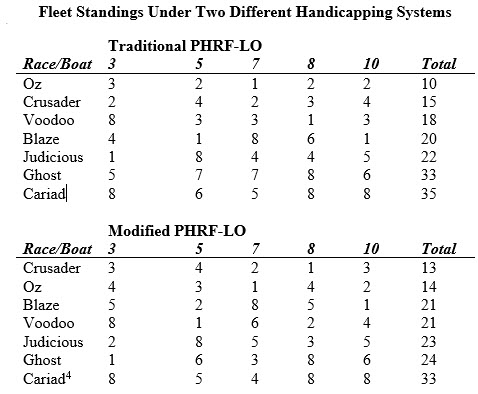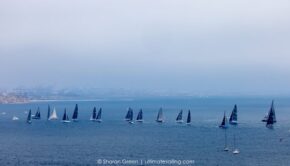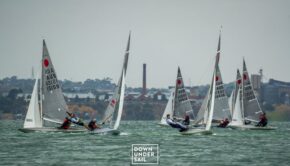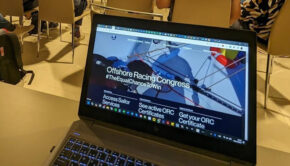Individual Performance Handicapping
Published on April 13th, 2017
An investigation into the effects of an Individual Performance Handicapping System on fleet competition at the local level by David Lochner and Richard White¹ at Oswego Yacht Club² in October 2015.
Fair competition is a central tenant in all athletic competition. Fairness can be realized in many ways. Team sports such as softball are organized in leagues based on skill levels. Bowlers are handicapped based on personal performance relative to a league standard. Personal performance and course difficulty are considered in golf handicapping.
Sailing is perhaps unique in that it handicaps boats and not sailors.
Historically, sailboat handicapping has followed one of three traditions; a one design rule, a measurement rule, and a performance handicap. Of interest here is the most commonly used performance handicapping rule, PHRF.
The language of PHRF is revealing in its intention, boats are assigned an “Adjusted Speed Potential” based on a base rating and any adjustments due to common modifications such as oversized sails, roller furling, folding/feathering props, and so forth. The implication of the ASP rating is that an optimal boat speed can be predicted based on past performance.
How fast a boat sails is dependent upon three broad factors. The boat as it was designed. The boat as it was built and modified. And the boat as it was prepared and sailed.
PHRF attempts to calculate a fair rating for a class of boats by aggregating the results from multiple races sailed by multiple boats driven by multiple crews. The resulting rating does provide a fair rating of a class of boats relative to another class of boats; however, it is less successful when applied to an individual boat.
Factors Affecting Boat Performance
While certainly not the intention of the builder or designer, all boats of a class do not leave the boat shed equally built. Some differences can be attributed to optional equipment selected by the original owner, others to inconsistencies in the building process.
It is a fairly common assumption that mass-produced sailboats did not always meet designed weights, especially hand laid fiberglass hulls. Hull weight is a factor in a boat’s speed, heavier hulls accelerate slower than light hulls of the same design and have lower top speeds. Weight differences can be quite substantial.
Consider a typical 30-foot racer/cruiser with a design weight of 8,000 pounds. If the boat is built with an exceptionally low weight tolerance of +/- 1% two boats coming from the factory could have a 160 lb weight difference, increase that tolerance to 5% and the potential difference increases to 800 pounds.
Over time any number of other modifications can be made that affect boat performance can be made. Some modifications such as, replacing wire/rope halyards with light high tech lines and repowering with modern lighter engines yield a lighter faster boat. While other modifications may add function and convenience at the expense of performance. Finally, wear and tear and incidental damage, such as a wet core, may result in a heavier slower boat.
The net result is that some boats in a class are inherently slower than others. Even with an expert crew the boat cannot be as competitive as a similar boat with an average crew. Based on these “boat as built and modified” factors, a class rating fails to appropriately handicap the boat.
A boat that is inherently faster than the class rating has an unfair advantage whereas a boat that inherently slower is at a disadvantage. An artifact of the rating system that is contrary to the notion of fair competition.
Apart from the boat, human factors play an important and obvious role in performance. The most salient human factor is sailing ability, highly skilled sailors will, by definition, sail faster than that less skilled sailors. At the club level interest is a factor, some skippers approach club racing as a recreational and social event, while others have a more competitive approach to racing.
Finally, not all skippers can bring equal resources to bear. Some skippers can afford to frequently replace sails, others struggle to meet basic ownership expenses. At the club level, these factors create a less than level playing field.
Boat vs Skipper Handicapping
Yacht racing handicaps are unique in that the handicap is based on the equipment of the sport rather than the competitor’s performance.
League based sports (softball, volleyball, etc.) sort players by skills with higher skilled players competing against higher skilled players. Individual sports (golf, bowling) handicap players based on their actual performance and not on the equipment of the sport. The type of golf clubs, golf balls, shoes, and bowling balls used by a golfer or bowler are not a factor when calculating handicaps. In deed, golfers and bowlers may use different equipment depending on the condition of the alleys or the characteristics of the course.
If golfers were handicapped in a manner similar to yachts, then each model and brand of clubs would have it’s own handicap based on the performance of everyone who used the same club model and brand. Under a system like this, woe to the average duffer who thought he could improve his game by using the same brand and model of clubs that PGA Tour Leaders use. Club manufacturers might well object to this kind of handicapping as their profits are based on the duffers’ belief that better clubs yield better scores.
Some parts of our sport implicitly recognize that not all boats of a class are equal, even with one-design boats. Scholastic competitors often use boats provided by the hosting school and sail in a round robin competition so that every crew sails on every boat. In the end no crew has an advantage due to boat factors alone, sailing skill determines the winner.
Why Does this Matter?
Sailing and competitive sailing in particular is experiencing a decline in participants. Many factors are contributing to this phenomena and they have been well documented in the sailing press and in at least one book, Nick Hayes’ Saving Sailing. One factor contributing to sailing’s decline at the local level is the dominance of a few boats in a fleet.
The lifeblood of our sport is the thousands of recreational sailors competing in Wednesday night beer can races. This is where sailors’ passions are ignited, youth are drawn to the sport, and competitive sailors hone their skills. This is the market that supports equipment manufacturers. This is the market for race worn competitive boats. This is the sport’s base.
Fair competition at this level is thwarted by a handicapping system that handicaps classes of boats rather than a skipper and a particular boat. In the absence of fair competition interest wanes in those middle of the fleet skippers and developing skippers who never see a podium finish. Recruiting and retaining crew, investing time and financial resources in to what seems to be a losing proposition does not bode well for fleet growth.
Consider this simple question: If the worst sailor in a fleet sails his best ever race while the best sailor in the fleet sails his worst ever race, who should win?
If you answer the worst sailor should win, then the next question is: Does the handicapping system enable this sailor to win?
The answer is that class based handicaps as opposed to individual skipper/boat handicaps do not enable the worst sailor to win. In effect, a class-based system provides an inherent advantage to the highly competitive top tier sailor who routinely sails faster than the class handicap. If this sailor routinely sails 12 sec/mile faster than the class handicap, then in effect he can give up 12 sec/mile and still sail at the class rating.
Conversely, if the worst sailor consistently sails 12 sec/mile slower than the class handicap, he has to make up those 12 sec/mile just to sail at the class handicap. In this hypothetical case there would be a 24 sec/mile difference in performance in what should be a fair and equal rating.
Characteristics of Fair Competition
The overarching assumptions thus far are simple; competition should be fair and fair competition is good for the sport. The disillusion that comes from unfair competition has been discussed, maintaining interest and willingness to invest are difficult to achieve from the back of the fleet.
All sailors should feel that they have a fair chance to win the race when they leave the dock. And that is the stated goal of handicapping boats; if all boats are equally well sailed and the handicaps are fair and accurate then all corrected times should be equal.
Competition at the club level is typically organized around a series of races grouped as season. Boats compete to win individual races and a championship for the series. Races are won based on elapsed times and series are won by winning points based on the race finishes. If the case to be made is that individual handicaps will yield improved competition, then how can improved competition be measured?
To reiterate, the goal of a fair handicapping system is that all boats that are equally well sailed will have equal corrected times. The definition of a competitive fleet may be a fleet in which the corrected times, in any given race, are very close. The corrected time difference between the first and last boat in a fleet serves as an objective measure of that fleets competitiveness with smaller corrected times suggesting a more competitive fleet.
Similarly, a competitive series is one in which the point differences between competing boats is small. A series in which the difference between any adjacent places is approaches zero would suggest a competitive fleet as a change of place in any one race would affect the out come of the series of races.
Assessing a Fleet’s Competitiveness
Central to this discussion is the notion that an individual handicapping system would yield a more competitive local fleet. Confirming that notion is a rather straightforward. The results from a series of races are scored twice, once using class based handicaps and once with an individual based handicaps. If corrected time differences are reduced and final standing point differences are reduced then fleet competitiveness has increased.
This method is purely a performance based assessment based on outcomes of actual races. An argument can be made that a results based method simply maintains the status quo and does not result in improved competition or better boat maintenance and preparation.
This argument rests on a definition of competition that is based on skills, with higher skills equated with higher levels of competition. For competitive sailors who seek competition above the local level, this is an important consideration. At the local level fostering skill improvement while maintaining fair competition can be managed through periodic reviews and adjustments to handicaps to reflect changes in performance.
Calculating an Individual Handicap
The mathematics of calculating a handicap in a small closed set are fairly simple. The mathematical goal is to produce a handicap or correction factor such that all the boats in a given race would tie. The time on time factor would be calculated thusly:
TOT = ETmedian /ETboat. (see note below)
Where TOT is the Time on Time handicap, ETboat is the elapsed time of the boat being handicapped and ETmedian is the median elapsed time for the race. Corrected times are then calculated as:
CT = TOT * ETboat
Where CT is the Corrected Time, TOT the Time on Time Handicap and ETboat is the elapsed time of the boat.
The utility of this approach is fairly limited. The resulting handicaps can only be used with the same set of boats competing against each other. A more elaborate calculation is necessary to yield results that can be generalized to different combinations of boats.
Fortunately, PHRF-LO had developed a spreadsheet to accomplish this. Referred to as the Corona Analysis³ spreadsheet it is calculates what might be called the Sailed To rating for every boat in a race and then aggregates each boat’s race performance and calculates then median, standard deviation, and the mean of each boat’s Sailed To ratings. The median rating yields a viable individual handicap.
The median, instead of an average rating, is used because a median is less sensitive to the magnitude of differences than the average. When averages are used an exceptionally poor or exceptionally good Sailed To rating can skew the average necessitating dropping or excluding these outlier results. Medians are not affected by outlier results, all that matters is whether the score is greater than or less than the median; magnitude of the difference is not important.
A Pilot Study
A pilot study was conducted using the results from the 2014 Summer Series at Oswego Yacht Club. Races that had a minimum of five qualifying boats competing were included. A qualifying boat had to have sailed at least three races during the series. In all, seven boats qualified in five races. (Data is available online).
The corrected time (CT) difference between the first boat and the last boat yields a measure of the fleets competitiveness and a measure of how well the handicapping system works. In a perfect system with perfect sailing there should be no difference in CT, therefore, the more equitable handicapping system will yield smaller deltas. In this sample the Modified PHRF-LO system yielded CT Deltas an average of 51% lower than the Traditional PHRF-LO system. The deltas ranged from 5% lower to 73% lower.
Increased competitiveness can also be demonstrated by differences in final standings, smaller differences between first and last place boats indicate a more competitive fleet. Under Traditional PHRF-LO HC there was 25-point difference between the first and last boat in the standings and only a 20-point difference in the Modified PHRF-LO system. While a 5-point difference may seem small, there was a 1-point difference between first and second place with the Modified PHRF-LO system and a 5-point difference under the traditional system. Small differences were also found in the middle of the standings. Under the Modified PHRF-LO system there is a 3-point difference between third and sixth place with a 15-point difference under the Traditional PHRF-LO system.
These results suggest that indeed, competition can be increased and made more equitable by using individual handicaps instead of class handicaps. However, the results are not without significant limitations. The primary limitation is small number of qualifying boats in a small number of races. Additionally, other non-qualifying boats may have competed in some of the included races. Nonetheless, the data is sufficiently robust to warrant further investigation.
Proposed Investigation
The purpose of this proposed study is to investigate the effects on competition and fairness of three different handicapping systems; Traditional PHRF-LO, Modified PHRF-LO, and the ECHO system. Fairness and competiveness will be gauged on three main dimensions: corrected time differences between the methods, point range in final standings for each method and, number of unique boats in the first four places in the final standings for each method.
It is hypothesized that:
1. Differences between the fastest and slowest corrected times will be smaller for the experimental systems when compared to the Traditional PHRF-LO system;
2. Difference in point totals in the final standings will be smaller in the experimental systems when compared to the Traditional PHRF system;
3. The number of unique boats in the top four places will be greater in the experimental systems than in the Traditional PHRF system;
4. Boats that sail more consistently will score higher in the standings than boats that sail less consistently; and
5. No differences will be found between the ECHO and Modified PHRF-LO scoring systems.
Procedure. A sample of race results from the 2015 sailing season will be collected from clubs competing under PHRF-LO authority. Each boat will receive a handicap based on its performance using the Modified PHRF-LO and ECHO methods. Results will be calculated using the Traditional PHRF-LO, Modified PHRF-LO and Echo handicaps. Corrected times and standings will be compared across the three methods to test hypotheses 1 to 3. A rank order correlation will be conducted using final standing position and the standard deviation of the weekly handicaps earned under the experimental conditions.
Sample Selection. It is proposed that the results from six race series be used for the analysis. Series will consistent of naturally occurring race series from Lake Ontario clubs divided into three groups: High HC (ASP > 190), Middle HC (190>ASP >140), and Low HC (ASP <140). Each group shall consist of two series from two different clubs.
Criteria for inclusion: All race series must meet the PHRF-LO criteria for inclusion in its analysis. In addition each series shall include at least five qualifying races with a minimum of six boats competing in each race. Individual boats must have sailed in at least 5 qualifying races to obtain a Modified PHRF-LO and Echo handicaps.
Note: In the original version of this article this formula was incorrectly reported. As initially reported faster boats would have gained a greater advantage over slow boats. Thanks to Dean Farrow of New Zealand for taking the time to point out this error.
1. The authors may be contacted at davelochner@mac.com and whitewick5@verizon.net.
2. Both authors are members of the Oswego Yacht Club, however, the opinions stated in this paper are the authors’ own opinions and not necessarily those of the Oswego Yacht Club. OYC’s endorsement or support of these ideas should not be implied.
3. The authors wish to recognize the tremendous efforts put in to the development of this spreadsheet by Steve Corona. His work has been immensely valuable to our efforts and key to developing our method.
4. Cariad competed in the requisite 3 races to establish a handicap, however, only 2 of those races were included in the 5 race sample. Scores of 8 indicate a DNS or DNF score.











 We’ll keep your information safe.
We’ll keep your information safe.